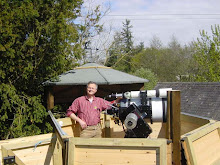This is my attempt to get organised - or rather to get the astronomy side of my life organised!
First things first - I do NOT perform well with a lack of sleep..... strange hobby to have then eh????
I am an astro IMAGER not a 'look through the eyepiece and see what's there' visual viewer. Yes, I do look visually as well but using basic equipment like binoculars. My primary time and effort is put into astro imaging and the equipment is all optimised for doing this.
My interest started relatively recently actually. A friend and colleague, himself a keen astro imager, aroused my interest when he emailed across some of the images he had taken. This was about 3 years ago now. I loved these photo's and this made me start to look upwards at night with a little more interest. I had a simple point and shoot digital camera and was really enthused when, with it mounted on a tripod, I actually managed to get star images!
Then, of course it all goes wrong... I want to get zoomed into the action - I need a telescope - I want to take long exposures to pick out the faint details and colour - I need a motorised mount - and on it goes - Aperture fever it's called in the astronomy community - bigger telescope = more light = fainter detail = MORE MONEY!!!
A major leap forward in practicality and efficiency was made this spring with the building of a permanent observatory to house the equipment.
The hexagonal shape was a bit of a headache to design as the roof has to slide off completely. The roof and part of four sides slides off together with the tops of the remaining two sides capable of being lowered separately. This gives the telescopes a pretty much clear view all round (limited by the trees and vegetation!).
The site is very good for astronomy - well away from towns and villages, no street lights and good clear views - all essential factors in obtaining the best from the equipment.






